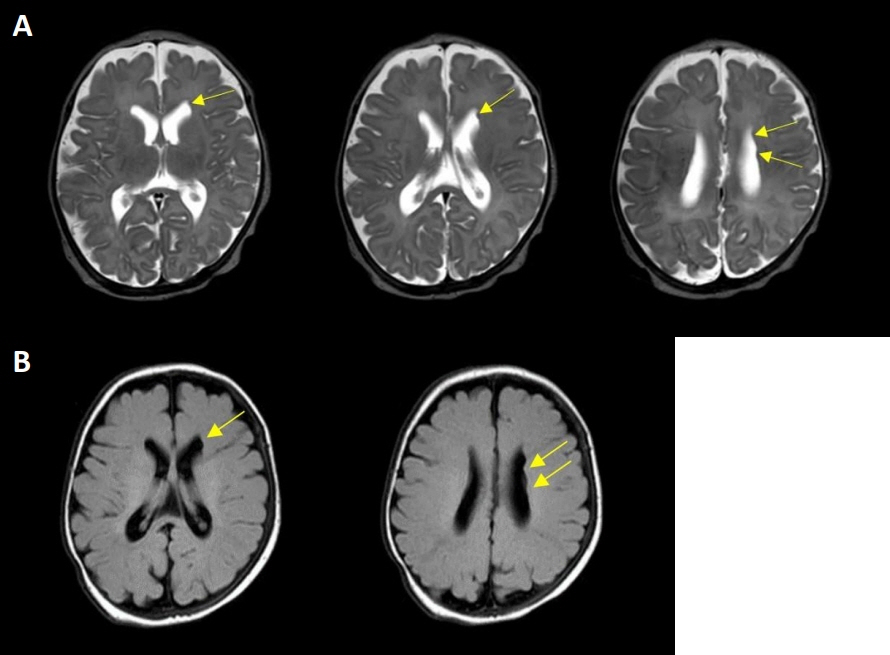Neonatal Med.
2022 Nov;29(4):149-153. 10.5385/nm.2022.29.4.149.
Newborn Periventricular Nodular Heterotopia with Persistent Feeding Cyanosis and Apneic Spell: A Case Report
- Affiliations
-
- 1Department of Pediatrics, Ajou University School of Medicine, Suwon, Korea
- 2Department of Radiology, Ajou University School of Medicine, Suwon, Korea
- 3Department of Medical Genetics, Ajou University School of Medicine, Suwon, Korea
- KMID: 2536661
- DOI: http://doi.org/10.5385/nm.2022.29.4.149
Abstract
- Periventricular nodular heterotopia (PNH) is a neuronal migration disorder that occurs during early brain development. Patients with PNH may be asymptomatic and have normal intelligence; however, PNH is also known to cause various symptoms such as seizures, dyslexia, and cardiovascular anomalies. PNH is not commonly diagnosed during early infancy because of the lack of clinical manifestations during this period. We present the case of a female infant diagnosed with PNH based on brain magnetic resonance imaging, who had symptomatic patent ductus arteriosus that had to be ligated surgically and had prolonged feeding cyanosis with frequent apneic spells.
Keyword
Figure
Reference
-
1. Guerrini R, Parrini E. Neuronal migration disorders. Neurobiol Dis. 2010; 38:154–66.2. Barkovich AJ, Kuzniecky RI. Gray matter heterotopia. Neurology. 2000; 55:1603–8.3. Lu J, Sheen V. Periventricular heterotopia. Epilepsy Behav. 2005; 7:143–9.4. Blondiaux E, Sileo C, Nahama-Allouche C, Moutard ML, Gelot A, Jouannic JM, et al. Periventricular nodular heterotopia on prenatal ultrasound and magnetic resonance imaging. Ultrasound Obstet Gynecol. 2013; 42:149–55.5. Zhou WD, Liu CH, Yin XM, Zeng QY. A novel mutation of Filamin A gene in a Chinese family with periventricular nodular heterotopia. Chin Med J (Engl). 2016; 129:2262–3.6. Parrini E, Ramazzotti A, Dobyns WB, Mei D, Moro F, Veggiotti P, et al. Periventricular heterotopia: phenotypic heterogeneity and correlation with Filamin A mutations. Brain. 2006; 129(Pt 7):1892–906.7. Vriend I, Oegema R. Genetic causes underlying grey matter heterotopia. Eur J Paediatr Neurol. 2021; 35:82–92.8. Demirel N, Ochoa R, Dishop MK, Holm T, Gershan W, Brottman G. Respiratory distress in a 2-month-old infant: Is the primary cause cardiac, pulmonary or both? Respir Med Case Rep. 2018; 25:61–5.9. Battaglia G, Granata T. Periventricular nodular heterotopia. Handb Clin Neurol. 2008; 87:177–89.10. Lange M, Kasper B, Bohring A, Rutsch F, Kluger G, Hoffjan S, et al. 47 patients with FLNA associated periventricular nodular heterotopia. Orphanet J Rare Dis. 2015; 10:134.11. Oegema R, Barakat TS, Wilke M, Stouffs K, Amrom D, Aronica E, et al. International consensus recommendations on the diagnostic work-up for malformations of cortical development. Nat Rev Neurol. 2020; 16:618–35.12. Cellini E, Vetro A, Conti V, Marini C, Doccini V, Clementella C, et al. Multiple genomic copy number variants associated with periventricular nodular heterotopia indicate extreme genetic heterogeneity. Eur J Hum Genet. 2019; 27:909–18.
- Full Text Links
- Actions
-
Cited
- CITED
-
- Close
- Share
- Similar articles
-
- Periventricular Heterotopia: A Case Report
- A Case of Wolf-Hirschhorn Syndrome with Periventricular Nodular Heterotopia Presenting with Status Epilepticus
- A case of FLNA gene mutation with respiratory insufficiency and periventricular heterotopia
- Periventricular nodular heterotopia in a child with a mild Mowat–Wilson phenotype caused by a novel missense mutation of ZEB2
- Aicardi Syndrome: A case report


